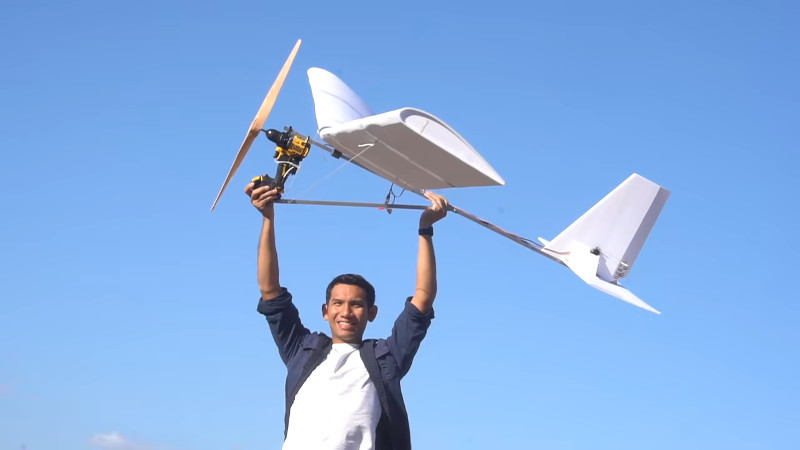Brushless motors and lithium batteries were a revolution for remote control aircraft. No longer would nitro engines rule the roost, as flying became far cheaper and more accessible almost overnight. The same technology has also found its way into power tools, leading to [Peter Sripol] deciding to build a powerdrill into a flying aircraft in this video, embedded below.
An unmodified DeWalt drill is the heart of the build, serving as the propulsion unit of the craft. A servo is used to actuate the drill’s trigger to serve as the throttle. As power drills are geared down significantly compared to a typical hobby brushless motor, it was necessary to use a much larger prop than would be usual. This was custom machined out of wood with the help of [William Osman], and despite some mishaps, came out (mostly) in one piece. The airframe consists of foam wings with poplar spars, and an aluminium extrusion serves as the tail boom. A few 3D printed parts then tie everything together.
Despite the weight of the drill, the hacked-together craft is able to fly quite easily. The large wings and propeller help to make up for the shortcomings of the powertrain. Unfortunately, there wasn’t quite enough surplus lift to carry a payload of smartphones to capture in-flight footage, but overall the project could be considered a resounding success.
We’ve seen [Peter]’s work before, too – sometimes even putting himself in the pilots seat! Video after the break.
















Nice meat slicer for dummies. I really was hoping for a cut leg on the first throw.
Hopefully it’ll come slice your face afterwards
Rood
I see cheap conversion kits coming from China.
All goofy video stuff aside, the semi-portable Shapeoko arrangement used to mill a propeller from substandard materials was kind of the understated star of all of this.
” No longer would nitro engines rule the roost, as flying became far cheaper and more accessible almost overnight.”
Decreased flight time and…”Unfortunately, there wasn’t quite enough surplus lift to carry a payload of smartphones to capture in-flight footage…”.
Take the battery off the drill and mount it further back with an extension cable to stop it being so nose heavy. Lithium battery instead of nicad. Double the wingspan. Just wait until a third world country builds one out of trash and adds some rockets. MacGyver would be proud.
Yemen says hi. They tend to use whipper-snipper motors and grenades though.
Long shaft on prop to move drill back underwing for improved C of G.
I’m no RC-ologist but I think you can get motors and batterys dedicated to RC planes cheaper than a dewalt drill and battery pack. But I’m still ok if you just want to build one for the hell of it and no doubt youtube clicks.
I did wonder if the efficiencies that could theoretically be gained by running a larger/slower prop would be more beneficial than the inefficiency of the gearbox power transfer and extra weight. Certainly, the drill has a different set of design tradeoffs that probably mean that this particular gearbox isn’t anywhere near optimized for this use.
Correction: replace “this particular gearbox isn’t” with “this particular gearbox and this particular prop aren’t”
I do get the feeling that there is more thought that goes into peter’s builds than what is shown in the video, but he spends his time on the parts and presentation style that actually make him revenue. I wish he would have a second channel that had less editing but had more technical/process level information. Maybe just dump all the raw footage on it and let the viewers sort out the bits of information. That being said, he probably should never look at the comments of that channel or he would never get anything done.